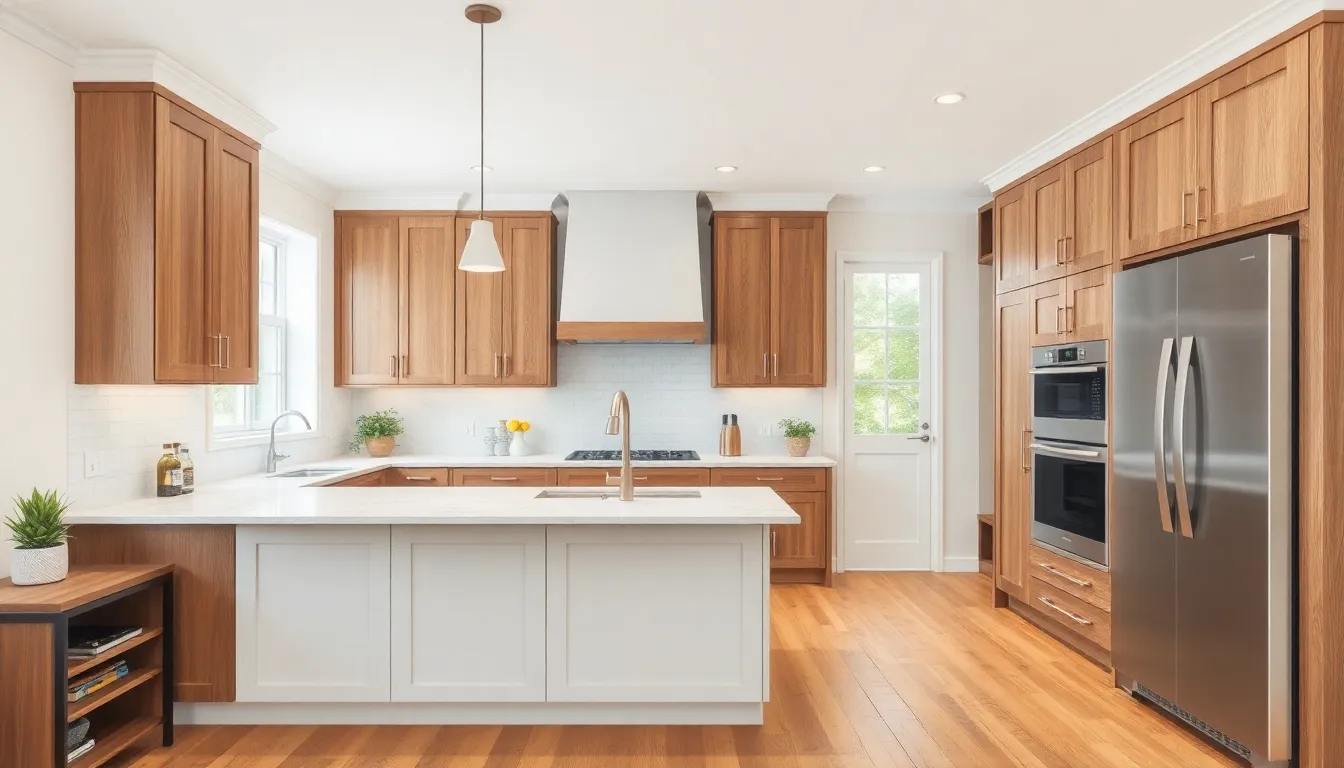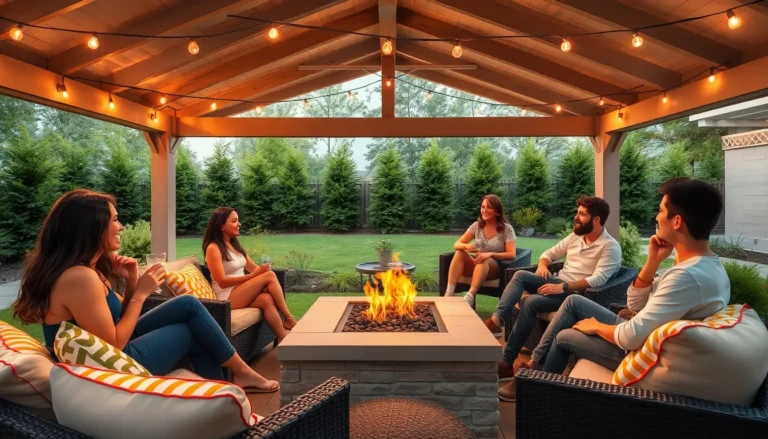Table of Contents
ToggleTransitional kitchens are the perfect blend of classic charm and modern flair, making them the go-to choice for homeowners who want it all. Imagine stepping into a space where sleek lines meet cozy warmth, creating an inviting atmosphere that says, “Welcome, let’s cook up some magic!” It’s the design equivalent of wearing a tuxedo with sneakers—stylish yet comfortable.
What Are Transitional Kitchens?
Transitional kitchens blend traditional and contemporary design elements seamlessly. These spaces emphasize simplicity while maintaining a sense of warmth and comfort. Homeowners often choose transitional styles for their versatility, allowing for personal expression through various materials and colors.
Design features frequently include clean lines and understated elegance. Cabinetry often showcases a mix of classic and modern styles, utilizing finishes such as white, grey, or natural wood. Countertops in transitional kitchens may incorporate materials like quartz or granite, balancing durability with aesthetic appeal.
Lighting plays an essential role in creating a welcoming atmosphere. It highlights key areas and enhances the overall design while often featuring sleek fixtures that complement the kitchen’s aesthetic. Appliances in transitional kitchens tend to blend with cabinetry, maintaining a cohesive look.
Colors in transitional kitchens usually reflect a neutral palette. Common shades include soft greys, creamy whites, and muted earth tones, which create a calming backdrop for the space. Accent colors such as navy blue or forest green may appear in accessories or decorative elements for a touch of personality.
Flooring options also vary, ranging from hardwood to tile, providing both style and functionality. This diversity allows homeowners to select materials that best suit their taste and lifestyle. Overall, transitional kitchens present an appealing choice for those who seek balance between classic charm and contemporary flair.
Key Features of Transitional Kitchens

Transitional kitchens offer a blend of elegance and comfort, showcasing design elements that appeal to various tastes.
Blend of Traditional and Modern Elements
Transitional kitchens expertly combine traditional charm with modern aesthetics. Homeowners enjoy classic cabinetry styles alongside contemporary finishes, creating visual interest. Clean lines define this space, balancing ornate details with simplicity. Furniture-like pieces bring warmth, while sleek appliances add a modern touch. This combination fosters a seamless flow, encouraging relaxation and functionality. By integrating various textures and profiles, transitional kitchens provide depth and character, making them inviting.
Color Schemes and Materials
Transitional kitchens often feature a neutral color palette, establishing a calm foundation. Shades of white, grey, and beige dominate, offering timeless appeal. Accents in bolder hues can enhance visual interest, allowing for personal expression. Materials like quartz and granite frequently serve as preferred choices for countertops, ensuring durability and style. Cabinets may showcase finishes ranging from natural wood to painted surfaces, promoting cohesion. Flooring varies from hardwood to tile, accommodating diverse preferences and lifestyles. These carefully selected elements contribute to the overall harmony and sophistication of transitional kitchens.
Designing Your Transitional Kitchen
Creating a transitional kitchen involves thoughtful design choices that enhance both function and style. Emphasizing balance and warmth, the layout must facilitate an inviting atmosphere for cooking and entertaining.
Layout Considerations
Functional triangles between the stove, sink, and refrigerator promote efficiency in transitional kitchen designs. Open floor plans allow for seamless flow between cooking and dining areas, enhancing social interaction. Including an island serves multiple purposes, offering additional workspace and seating. Placing cabinetry strategically maximizes storage without overcrowding the space. Opting for defined zones—such as prep, cooking, and dining areas—adds organization to the kitchen. Each layout decision influences the overall ambiance, ensuring the kitchen feels modern yet approachable.
Selecting the Right Appliances
Choosing the right appliances is critical in a transitional kitchen. Stainless steel models provide a sleek look, harmonizing with both classic and contemporary elements. Energy-efficient options not only save on utility bills but also align with modern values of sustainability. Integrating built-in appliances helps maintain clean lines and reduce visual clutter. Selecting a double oven or a five-burner cooktop increases functionality for those who enjoy cooking. Including smart appliances enhances convenience while fitting the stylish aesthetic of the kitchen. Each appliance contributes to the kitchen’s functionality and overall appeal.
Benefits of Transitional Kitchens
Transitional kitchens offer a blend of style and functionality, making them highly sought after by homeowners. They create inviting spaces due to their balance of classic elegance and modern aesthetics. Functionality remains a priority, as clean lines and efficient layouts promote ease of movement while preparing meals. Customizable design elements allow for individual expression, catering to varied personal tastes.
Versatile materials play a crucial role in transitional kitchens. Homeowners often choose durable and stylish options like quartz and granite for countertops, enhancing both beauty and longevity. A neutral color palette typically serves as a backdrop, with vibrant accent colors that add personality and warmth.
Storage solutions in transitional kitchens maximize organization. Thoughtful cabinetry placement creates effortless access to cooking essentials. Open shelving is a popular choice, allowing for both display and accessibility, while islands increase workspace and serve as gathering spots.
Lighting contributes significantly to the ambiance in transitional kitchens. Modern fixtures complement the overall design while providing adequate illumination for daily tasks. Natural light through strategically placed windows enhances the welcoming atmosphere during the day.
Energy-efficient appliances add modern convenience and sustainability to these kitchens. Stainless steel models align with the sleek aesthetic, while built-in options maintain clean lines. Features like smart technology streamline cooking processes and improve overall energy management.
Overall, transitional kitchens blend elegance, practicality, and personal expression, making them ideal for today’s modern homeowner. They set the stage for culinary creativity while maintaining warmth and inviting charm.
Transitional kitchens embody the perfect balance of style and functionality. They invite homeowners to express their unique tastes while enjoying a space that feels both modern and timeless. With their clean lines and warm aesthetics they create an atmosphere that’s ideal for cooking and gathering.
The thoughtful design elements and versatile materials ensure these kitchens remain practical and inviting. As they continue to gain popularity among homeowners it’s clear that transitional kitchens are more than just a trend; they’re a lasting choice that enhances the heart of the home.




